| 1 | Common garter snake |
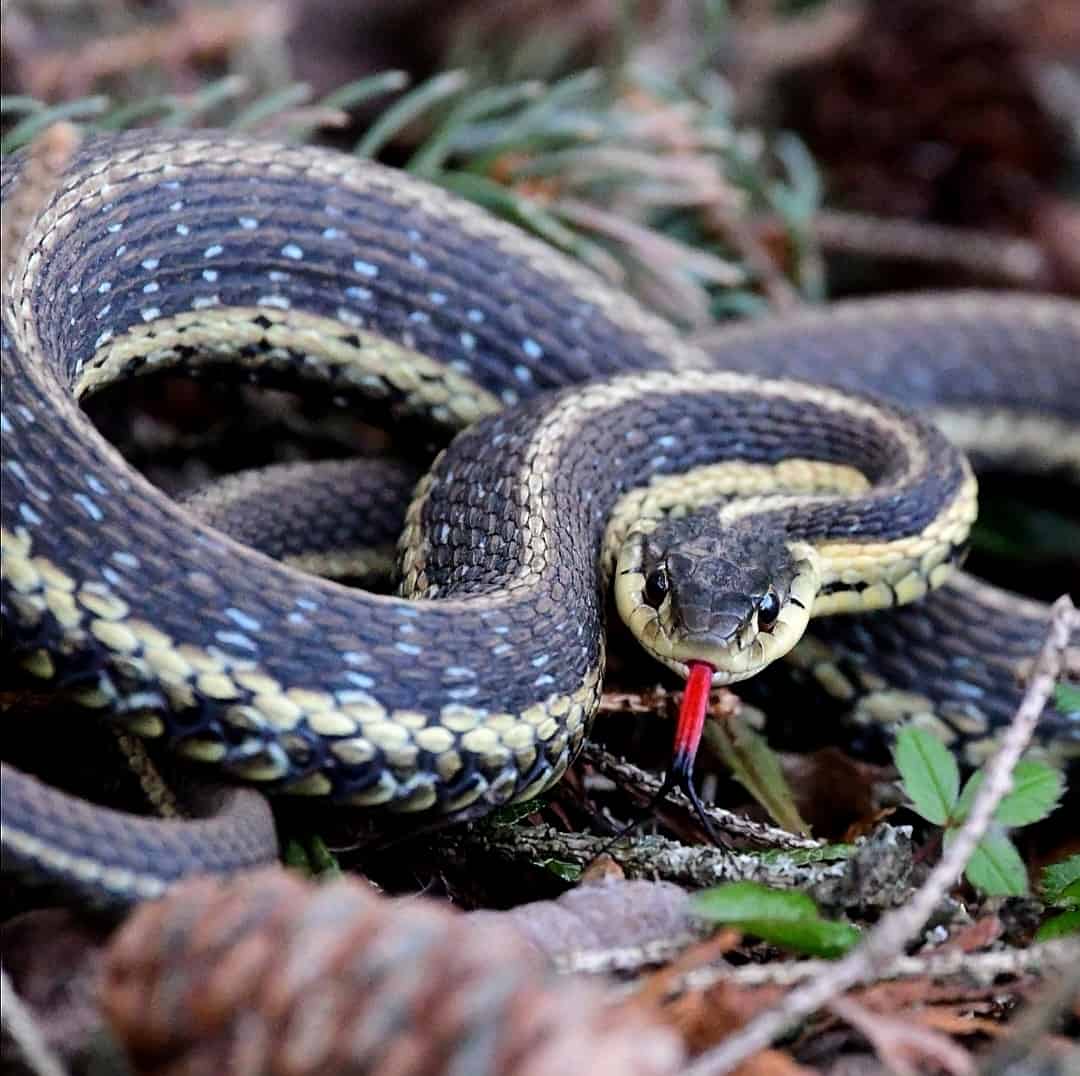
Latin: Thamnophis sirtalis.
Range: virtually the entire USA, most of southern Canada. A tiny population in northern Mexico (Chihuahua).
The garter snake which all others are judged against. The common garter snake is the most widespread reptile, not just snake, in the whole of North America. It inhabits every lower 48 US state except Arizona, and is the sole snake found in the frigid Northwest Territories (NWT) region of Canada. It may, just may, reach southeastern Alaska (still unconfirmed).
At a maximum of 137.2cm, this is one of the larger garter snake members. For reasons nobody knows, common garter snakes can cope with far more varied habitats than their cousins. Thick forests, town gardens, and rocky shrubland are acceptable, with only deserts being truly out of bounds for them.
Nevertheless, their favourite spots are undoubtedly grassy meadows not far from streams or ponds. These moist zones are home to their favourite prey, amphibians and earthworms. Common garter snakes are non-aggressive, but manufacture a few toxins in their saliva, which can surprise bite victims with their strength.
Thamnophis sirtalis coexists with virtually all other garter snake species on this list, as though it’s the main garter snake from headquarters supervising all the smaller ones, which have been handed smaller slices of territory. Common garter snakes also have 13 varying subspecies, including the red-sided garter snake, which has red and blue tinges. However, this article will only cover the full species of the garter snake genus (Thamnophis).
| 2 | Eastern ribbon snake |
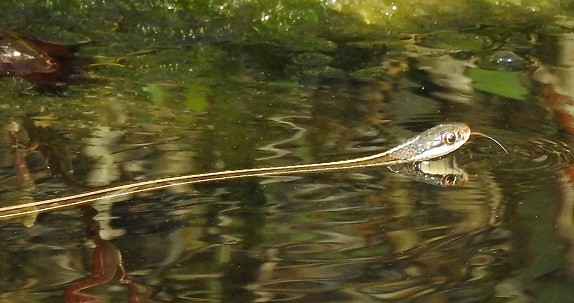
Latin: Thamnophis sauritus.
Range: eastern USA, Ontario.
The most aquatic member of the Thamnophis genus. While possessing a fancier name, and occupying a more distant branch on the evolutionary tree, the eastern ribbon snake is still classed as an official garter snake member.
Eastern ribbon snakes (Thamnophis sauritus) are most common in the northeastern US, appearing in countryside streams of Ohio, Pennsylvania and New York state. They have many survival tricks up their sleeves, such as shifting warmth from their tail to their bodies during cold weather, and climbing 6 metres high into riverside branches to dodge sudden floods, which they have a mysterious ability to anticipate.
Many riverside dog walkers have misidentified this snake over the years, but this is one of the easiest garter snake species to distinguish. Their belly tends to be paler than the common garter snake’s, and their faces are cleaner, with less markings. Eastern ribbon snakes are also the thinnest Thamnophis member, and have a signature white dot in front of each eye.
Eastern ribbon snakes measure up to 101.8cm, and source over 90% of their calories from amphibians, with a bonus helping of caterpillars and fish. Studies reveal that the northern leopard frog is their favourite prey of all. Eastern ribbon snakes use neither venom nor constriction, preferring to grab a frog and swallow it down using whatever clumsy methods possible.
| 3 | Aquatic garter snake |
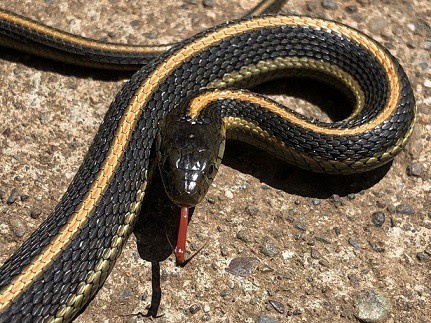
Latin: Thamnophis atratus.
Range: California, Oregon.
A species found in just two US states. The aquatic garter snake isn’t fully water-dwelling like a sea snake, but definitely gravitates towards water more than most of its cousins.
This species is most commonly spotted swimming in streams, ponds, and marshes, along the west coasts of California and Oregon where they reside. At least 80% of their diet consists of frogs and toads, with the rest being salamanders. They’re even able to use their tongues to mimic insects, poking it just below the water surface to attract curious fish.
Aquatic garter snakes reach a maximum of 101.6cm, and are easy to identify. They’re often completely missing the stripes on their sides, and the yellow stripe down their spine is thicker and blotchier than usual.
A study from Saint Lucia Preserve revealed how the group compares. 3 garter snakes lived side by side in the study zone, and the local aquatic garter snakes were always found 1 metre or less from a pond. The common garter snakes reached 20 metres away from pond edges, while the terrestrial garter snakes were often found hiding under cover in grassy fields, 50 metres away from the nearest water body.
| 4 | Terrestrial garter snake |
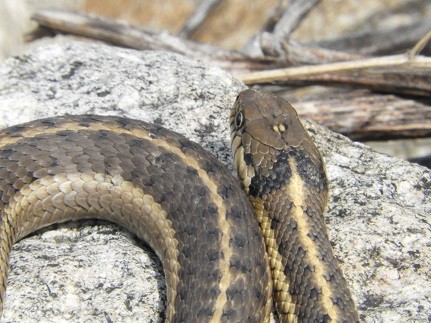
Latin: Thamnophis elegans.
Range: western USA, southern Canada.
The second most sprawling garter snake after the common one, occupying 14 states, and just reaching far western Oklahoma and Nebraska. Terrestrial garter snakes (Thamnophis elegans) are extremely flexible and can inhabit grassy fields, forests, streams and rocky shrubland.
Their diet is the most varied out of any garter snake, shifting effortlessly within one location. In one river, the local terrestrial garter snakes ate 56.2% crayfish, with a side helping of voles, while in the Saint Lucia Preserve of Monterey County, California, mammals made up 82% of their diet. Yet another dataset found that fish made up 38%, frogs and toads 23%, and mammals just 2%. Either way, the terrestrial garter snake is much more likely to eat mammals than other Thamnophis members. The common garter snakes in Saint Lucia Preserve ate no mammals at all.
This species is tricky to distinguish from common garter snakes, but has a larger saliva gland and several scale differentiations. They’re also smaller than the common garter snake, with a record length of 109.2cm versus 137.2cm. Despite a similar appearance, the two have a large genetic chasm between them.
Thamnophis elegans is the most likely garter snake to constrict its prey, and their venom also seems particularly severe. They’re don’t come close to an Egyptian cobra, but one prolonged bite resulted in swelling, pain and local haemorrhaging.
| 5 | Giant garter snake |
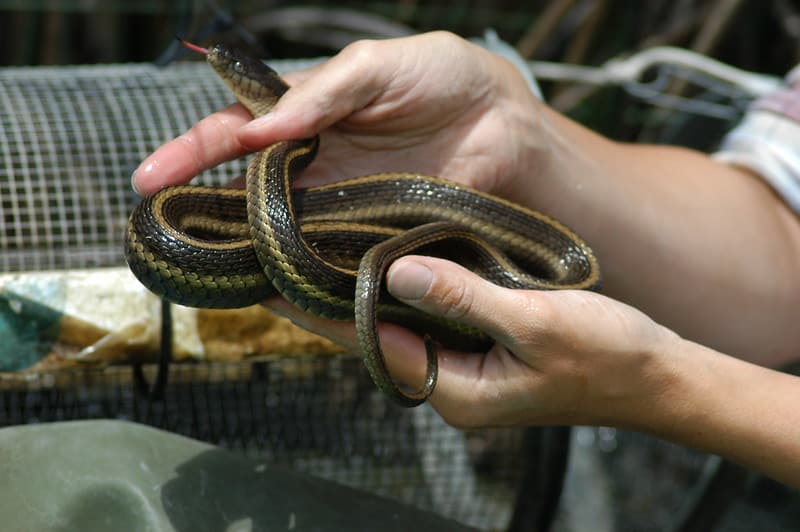
Latin: Thamnophis gigas.
Range: California.
The largest garter snake of the USA, but also the most endangered. Giant garter snakes can reach 162.6cm, and exclusively inhabit the Sacramento and San Joaquin valleys of California. As of 2022, just 10% of their 19th century ranges remain.
This is a strongly aquatic species which once roamed freely around unending marshlands, which have long since been absorbed by agriculture. Their only saving grace is that Sacramento is now covered with rice paddies, which are semi-flooded and have numerous water drainage channels, making them a perfect mimic of their true habitat.
Giant garter snakes correlate closely with one plant: long strands of tule. Their favourite marshes are ones with heavy borders of vegetation, but also gaps they can slither through, in order to inspect dry land.
Giant garter snakes have the sneaky skill of slithering through water culverts and crossing busy highways, without having to run the gauntlet of speeding cars. Their diet is heavily reliant on frogs, including the Sierran tree frog, with a side helping of fish. Giant garter snakes are mostly lethargic, but can slither up to 5 miles in a few days when on a quest for new territory.
| 6 | Northwestern garter snake |
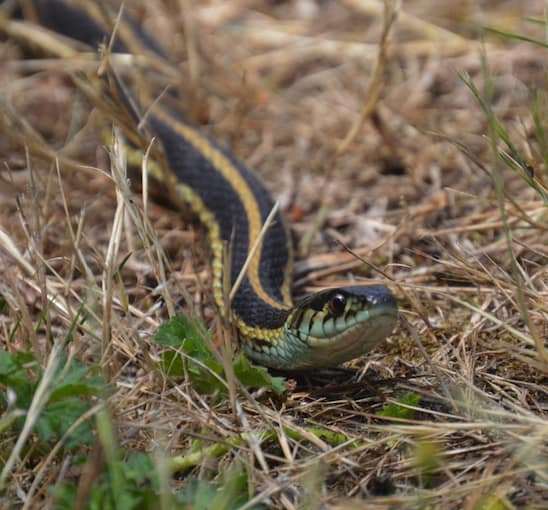
Latin: Thamnophis ordinoides.
Range: Washington, Oregon, northern California.
This garter snake is one of the most variable in colour, as red, blue, orange and green striped versions can regularly be found within the same field. Northwestern garter snakes are relatively short, averaging at 40cm and reaching a maximum of 96.5cm. They also have a smaller head than most, with the same red tongue as usual. They’re one of the least aquatic garter snakes, appearing in water occasionally, but mostly sticking to open fields on the edges of forests.
Even the pattern itself varies with this garter snake, and strangely, scientists have found that this correlates with personality. Striped versions are more likely to flee in a straight line, while those with spots or no patterns dart to the side and then pause, seeking camouflage. Northwestern garter snakes mostly eat small, slimy creatures, the kind that destroy your garden crops: slugs and earthworms. Two of their favourite species are the banana slug and dew worm.
A difference to the common garter snake is that they often have vivid red spots on their bellies. Northwestern garter snakes are also found in southwestern British Columbia.
| 7 | Sierra garter snake |
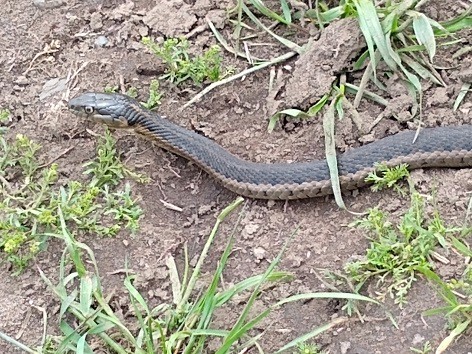
Latin: Thamnophis couchii.
Range: California, far western Nevada.
This Californian garter snake is easily one of the most recognisable Thamnophis members. They have one of the blackest bodies, with an undercurrent of vivid orange, and the standard spine stripe is as thin as a pencil line.
Thamnophis couchii is one of the more aquatic garter snakes. As hatchlings, they hunt in shallower waters, before moving to the deeper river centres as adults. One of their favourite foods is newborns of the Pacific giant salamander, and a large chunk of their diet comes from fish. This garter snake has also evolved resistance to the orange-bellied newt (endemic to California) and its deadly tetrodotoxins.
Sierra garter snakes have a reputation for aggression in captivity, meaning that they’re rarely kept. Keepers have tried and failed to get them attuned to rodents, even tempting them with artificially swabbed scents.
Sierra garter snakes reach relatively high altitudes, as they’re often found in high mountain streams of the Californian Sierra Nevada. Elevations of 2440 metres have been confirmed, but there’s even rumours of Sierra garter snakes living at 2500 metres in El Dorado county. As for their length, this species reaches a minimum estimate of 125.9cm, possibly more.
| 8 | Short-headed garter snake |
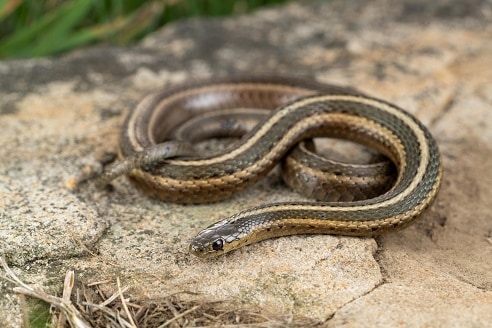
Latin: Thamnophis brachystoma.
Range: New York, Pennsylvania.
This species has one of the smallest territories of all US garter snakes. New York state and northwest Pennsylvania are their sole natural bases, with introduced populations in southern Pennsylvania. Within those ranges, they’re very common, but they disappear very suddenly on the outskirts, despite no change in habitat type.
Short-headed garter snakes tend to live in meadows, and occasionally forests adjacent to them. They’re shier than average, and hide under rocks and wood. Being a small garter snake, at an average of just 36.7cm for males and 41.8cm for females, most of their diet consists of earthworms. The record length is a mere 57.8cm.
This northeasterly species is easily confused with the common garter snake. However, as you’d expect, the head is the easiest separator. It’s extremely tiny in the short-headed garter snake, measuring just 4.3% of its body length. Unlike the common garter, the head is barely larger than its neck, carrying on like a tube, which is noticeable in the image above.
Short-headed garter snakes also look very “clean”. They have a pale stripe down their spine and on each flank, but between these stripes, there are no scattered markings, just a neat and consistent brown colour.
| 9 | Plains garter snake |
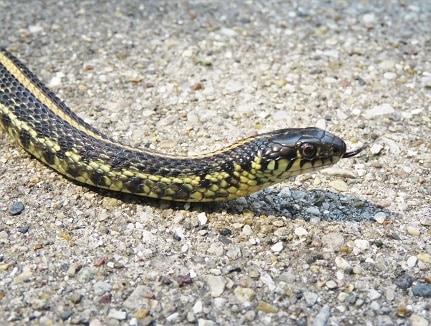
Latin: Thamnophis radix.
Range: central northern USA and southern central Canada.
Of all Thamnophis members worldwide, the plains garter snake is the most similar to the common, the trickiest to distinguish by appearance alone. This species inhabits northern US states such as Ohio, Wisconsin and Minnesota, and spills well across the Canadian border.
Plains and common garter snakes are regularly found just metres from each other in the very same fields. Their daily lifestyle is similar, moving most between 1-3pm, and sticking close to water bodies without being fully aquatic. Even their diet is extremely similar, relying on amphibians with a 5-10% supplementary helping of earthworms.
Yet the two are completely genetically separate, as they never interbreed and produce hybrids in the spots where they coexist. There are clearly differences which science hasn’t pinpointed yet, and the main confirmed one is that plains garter snakes are less flexible in their habitats, while common garter snakes can inhabit virtually anywhere except deserts (hence why they’re missing from Arizona). A study in Ohio found that common garters are more common in forests, while Thamnophis radix preferred wet prairies.
The physical differences are only subtle, but plains garter snakes have a more strongly orange stripe down their spine. The inbetween scales are also darker on average, creating a more vivid contrast. This is a medium-sized garter snake, at an all-time record of 109.3cm.
| 10 | Butler’s garter snake |
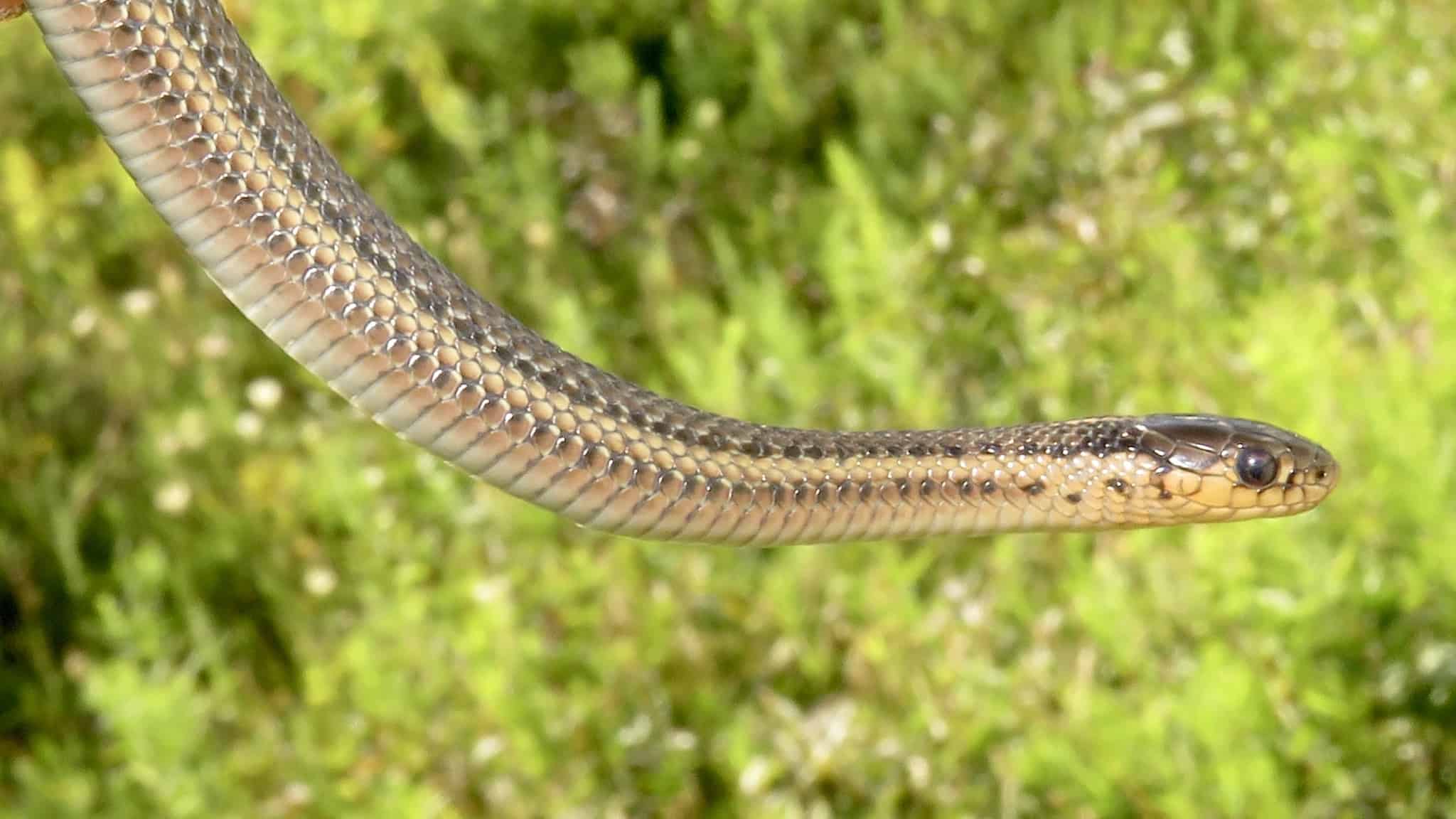
Latin: Thamnophis butleri.
Range: northern USA, Ontario.
This small garter snake is found in four US states: Michigan, Wisconsin, Indiana, and Ohio. Butler’s garter snakes live in wet meadows and tall grass prairie, often taking refuge in the burrows of chimney crayfish. They have the usual liking for moisture, but prefer open areas rather than forests. They move an average of 14 metres per day, accelerating during summer.
Butler’s garter snake is one of the shorter US species, with a female record length of just 73.7cm. Their other characteristics, however, are nearly impossible to separate from common garter snakes. The only hope for a layman is their pale side stripes. In common garter snakes, these are centred on the 2nd and 3rd rows of scales above their underside, while in Butler’s garter snake, they’re centred on rows 3 and 4.
Butler’s garter snakes almost never swim in rivers or lakes, but like to hide in 8 inch high vegetation on their borders. Consequently, Butler’s garter snake is able to use these as a corridor to infiltrate towns. They’re one of the more suburban-friendly members, and are sometimes found under scattered rubbish in vacant lots.
Nowadays, Butler’s garter snake derives 83% of its calories from earthworms, which aren’t native to the USA. They likely ate slugs before they were introduced.
